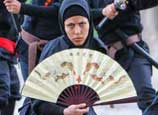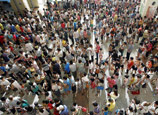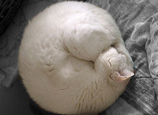
The Mausoleum of the First Qin Emperor was originally called “Lishan Mountain.” According to a record made in the period of the Three Kingdom, “the tomb is over 50 zhang high, and the perimeter of its bottom is over five li ” That means the mausoleum is over 120 meters high and its perimeter at the bottom is over 2,167 meters. On the surface of the mausoleum, grass and trees are growing. It really looks like a mountain. Li Daoyuan (466 or 472 A.D.—527 A.D.), a great geographer of the Northern Wei Dynasty, said that since the place where the tomb was built was full of sand and rocks but short of pure loess, they transported the loess to the tomb from Wujiazhaizi, a place 2.5 kilometers to the northeast of the tomb. This “Lishan Mountain” which was built completely by manual work showed the wisdom and power of the working people in ancient times.
In ancient times, in order to offer sacrifices to the emperors that had passed away, the people usually built temples beside their tombs and kept the crowns, clothes and memorial tablets of the dead in temples. They also built walls around the tombs and temples to protect them. That was the so-called “tomb park.” The custom of building the “tomb park” also started from the Qin Dynasty. The special point of the Mausoleum of the First Qin Emperor was that it had two layers of solid soil walls, which represented the city walls and the palace walls respectively. The grave chamber of the emperor was located in the southern part of the inner city and was like an inverted funnel in shape. Currently, it is 51 meters high and the perimeter of its bottom is over 1,700 meters. According to historical records, various palaces were also built in the mausoleum where extremely rare treasures were displayed. Around the mausoleum, there are also many pits for those buried with the emperor and tombs scattered around, and over 400 pits of such kinds have been verified so far.
According to the “Records of the Grand Historian,” Ying Zheng succeeded to the throne when he was only 13 years old (246 B.C.), and he immediately started the construction of the mausoleum after the succession. After he united China, he summoned over 700,000 people from all over China to participate in the construction of the mausoleum. The construction had not been completed even when he died at 50 years old (210 B.C.). The Second Qin Emperor continued the construction for another two years, and the work took over 40 years in total. It was really a huge project.
The “Records of the Grand Historian” also had records on the underground palace and the layout of the Mausoleum of the First Qin Emperor. The underground palace is very deep and solid. The walls of the underground palace were covered with “watermark stones” to protect against the water from underground rivers and were also coated with “red paint,” a kind of paint, to protect them against the moisture. The mausoleum has a palace and sitting arrangements for senior officials of all ranks and descriptions and was full with treasures. It is lit by candles made from the fat of a legendary four-foot fish in the East Sea with the similar shape to mankind, and the light would never go out. In order to prevent grave thefts, the tomb was equipped with crossbows that will shoot arrows if people enter the tomb. Quicksilver was injected to flow around the tomb like rivers and sea. The dome of the tomb is built in the shape of the sky with the sun and moon, and the ground of the tomb is built in the shape of land with mountains and plains. Therefore, the tomb is actually an underground microcosm of the human world. Historical records also said that the second emperor of the Qin Dynasty ordered all maids without children in Qin Shihuang’s palace to be buried with Qin Shihuang. In order to keep it secret, he also ordered soldiers to close the entrance of the tomb burying the construction workers alive inside.
The terracotta warrior and horse pits, 1,500 meters to the east of the Mausoleum of the First Qin Emperor, are the accessory pits. The three pits that have been discovered were laid out in the form of the Chinese character “品” and 8,000 life-size terracotta warriors and horses were unearthed from the three pits. The facial expressions of the terracotta warriors are very lively and their images are precise and dignified. The horses look realistic and were carved exquisitely and naturally. The terracotta warriors and horses are the symbol of Qin Dynasty’s strong army and their arrangement is just like the military formations. The accessory pits are tunnel-style buildings with a soil and wood structure. The terracotta warriors inside the pits look like palace guards to protect the underground palace. Judging from the structures of the pits and the equipment of the terracotta warriors and horses, the No.1 Pit represents the main force composed by infantrymen and chariots. The No.2 Pit is a hybrid force composed of infantrymen, cavalry, and chariot soldiers. The No.3 Pit is the military command post to command the troops from the No.1 Pit and the No.2 Pit.
 |  |
















 Wild Siberian tiger kills cattle in NE China
Wild Siberian tiger kills cattle in NE China


![]()
